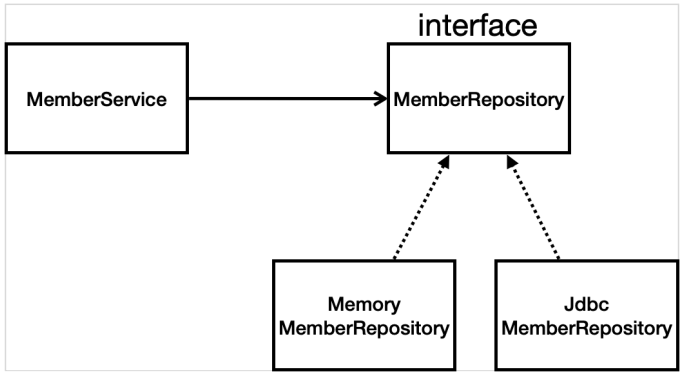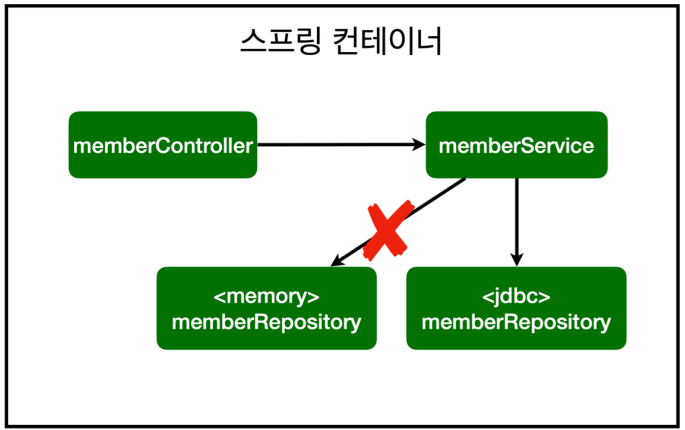1. JDBC 구현 이해하기
[ 구현 클래스 ]
[ 스프링 설정 ]
- 스프링의 DI (Dependencies Injection)을 사용하면 기존 코드를 전혀 손대지 않고, 설정만으로 구현 클래스 변경 가능
- 데이터를 DB에 저장하므로 스프링 서버를 다시 실행해도 데이터가 안전하게 저장됨
2. 코드 작성
[ 환경설정 ]
1. build.gradle파일
implementation 'org.springframework.boot:spring-boot-starter-jdbc'
runtimeOnly 'com.h2database:h2'
- jdbc, h2 데이터베이스 관련 라이브러리 추가
2. resources/application.properties
spring.datasource.url=jdbc:h2:tcp://localhost/~/test
spring.datasource.driver-class-name=org.h2.Driver
spring.datasource.username=sa
- 스프링 부트 데이터베이스 연결 설정 추가
- 스프링부트 2.4부터는
spring.datasource.username=sa 꼭 추가해야함
- 그렇지 않으면
Wrong user name or password에러 발생
- 마지막에 공백 들어가면 오류 발생
[ Jdbc 리포지토리 구현 ]
1. build.gradle파일
implementation 'org.springframework.boot:spring-boot-starter-jdbc'
runtimeOnly 'com.h2database:h2'
- jdbc, h2 데이터베이스 관련 라이브러리 추가
2. resources/application.properties
spring.datasource.url=jdbc:h2:tcp://localhost/~/test
spring.datasource.driver-class-name=org.h2.Driver
spring.datasource.username=sa
- 스프링 부트 데이터베이스 연결 설정 추가
- 스프링부트 2.4부터는
spring.datasource.username=sa 꼭 추가해야함
- 그렇지 않으면
Wrong user name or password에러 발생
- 마지막에 공백 들어가면 오류 발생
3. JdbcMemberRepository
package hello.hellospring.repository;
import hello.hellospring.domain.Member;
import org.springframework.jdbc.datasource.DataSourceUtils;
import javax.sql.DataSource;
import java.sql.*;
import java.util.ArrayList;
import java.util.List;
import java.util.Optional;
public class JdbcMemberRepository implements MemberRepository{
private final DataSource dataSource;
public JdbcMemberRepository(DataSource dataSource) {
this.dataSource = dataSource;
}
@Override
public Member save(Member member) {
String sql = "insert into member(name) values(?)";
Connection conn = null;
PreparedStatement pstmt = null;
ResultSet rs = null;
try {
conn = getConnection();
pstmt = conn.prepareStatement(sql, Statement.RETURN_GENERATED_KEYS);
pstmt.setString(1, member.getName());
pstmt.executeUpdate();
rs = pstmt.getGeneratedKeys();
if (rs.next()) {
member.setId(rs.getLong(1));
} else {
throw new SQLException("id 조회 실패");
}
return member;
} catch (Exception e) {
throw new IllegalStateException(e);
} finally {
close(conn, pstmt, rs);
}
}
private Connection getConnection() {
return DataSourceUtils.getConnection(dataSource);
}
private void close(Connection conn, PreparedStatement pstmt, ResultSet rs)
{
try {
if (rs != null) {
rs.close();
}
} catch (SQLException e) {
e.printStackTrace();
}
try {
if (pstmt != null) {
pstmt.close();
}
} catch (SQLException e) {
e.printStackTrace();
}
try {
if (conn != null) {
close(conn);
}
} catch (SQLException e) {
e.printStackTrace();
}
}
private void close(Connection conn) throws SQLException {
DataSourceUtils.releaseConnection(conn, dataSource);
}
}
- save, findById 등 매 함수마다 close(conn, pstmt, rs);를 통한 리소스 반환필수!
4. SpringConfig
@Configuration
public class SpringConfig {
private final DataSource dataSource;
public SpringConfig(DataSource dataSource) {
this.dataSource = dataSource;
}
@Bean
public MemberRepository memberRepository() {
return new JdbcMemberRepository(dataSource);
}
}
- DataSource는 데이터베이스 커넥션을 얻을 때 사용하는 객체


